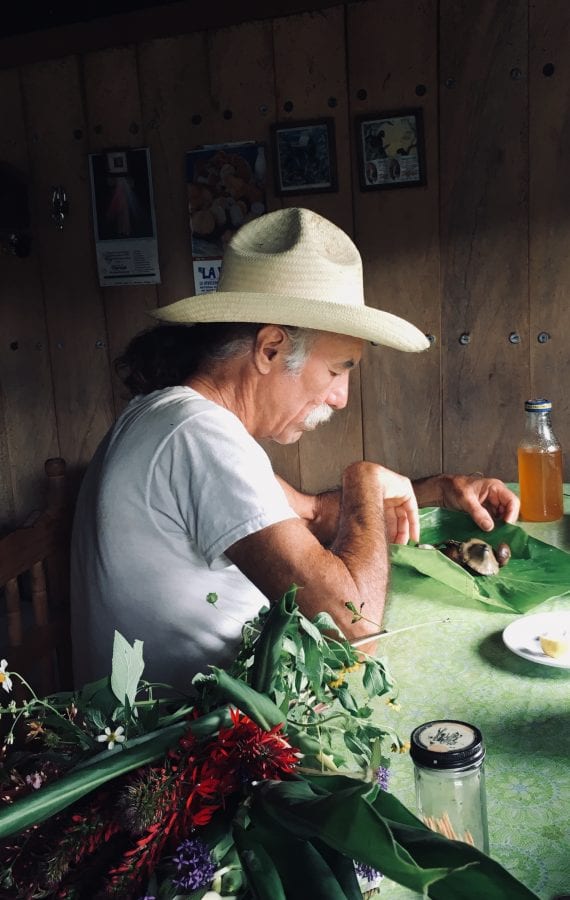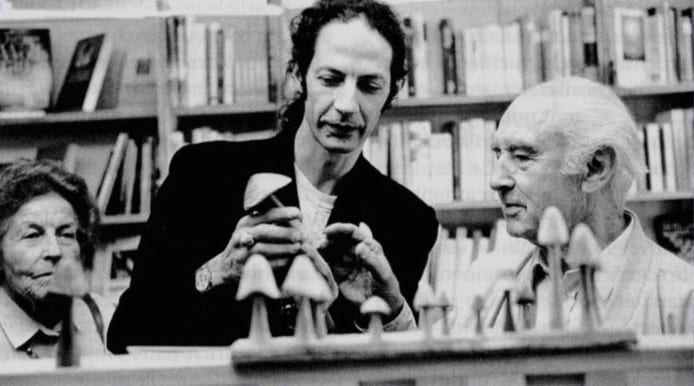Tracing the Steps of the Ghost Dance’ is a storytelling project about the importance of the ancient relationship between people, plants and their environment. Using the Ghost Dance ritual as our case study; we follow the spores of the Desheto mushroom to the impenetrable and majestic Cloud Forests of the Sierra Mazateca. This project is being led by our Americas project director Michael Stuart Ani, who has been a student of plant wisdom for fifty years with a deep connection to the Lakota, Yamomami and Mazateca.
To (re)read the fourth part of this journey, visit
The white man’s mushroom
Michael Stuart Ani arrived in the Mazateca at the end of the sixties, shortly after the first dirt road was built. It took him a fourteen-hour life and death, white knuckle, ride to get up the mountain. With the new road, a flood of rock stars like John Lennon, Bob Dylan and Mick Jagger and their fans invaded the hamlet of Huautla, looking for a more natural way to ‘expand their consciousness’ than through LSD. Caught in a quagmire, the locals who were living in poverty were trapped between the possibility of making money and their deepest beliefs. They wanted to sell the tourists mushrooms but were deeply afraid of the taboos of a mushroom whose name could not even be mentioned.
To work around this conflict the local Indians avoided using the name Desheto and began to call them ‘derumbes’, the Spanish word for landslide, since so many strains of psychoactive mushrooms in the Mazateca grew in landslides. After the hippies turned the Mazatecan’s most sacred ritual into a guitar strumming drug and sex festival, the municipal president of Huautla outlawed the mushroom’s sale. He did allow the desperately poor locals to sell the plentiful Psilocybin Cubensis mushrooms they called ‘San Isidros’ which grew from Brahman cow dung and sugarcane fields. This is the mushroom that became known in popular culture as the ‘Magic Mushroom’.
The local people never ate this mushroom, they believed it was the mushroom of white men’s saints because it grew in the waste (cow dung) of animals that Europeans had introduced to the region. They saw no connection between the San Isidros and their own ancient culture. At some point in this era a myth arose that these magic mushrooms could show you where treasures were buried because the Indians believed that the hippies came to eat them so they could find treasures and become rich like the rock stars. But the hippies and rock stars were not conditioned to survive in the harsh rural conditions and left before the Mexican military closed Huautla off to the outside world.

It was during this time that Michael stayed behind. Avoiding Huautla completely, he moved to the most remote side of the mountain where the tropical cloud forests were located and where Desheto actually grew. The people of Huautla claimed that the Indians of the forest would rob and kill any outsiders, but they allowed him to stay because they believed that Desheto had brought him there with a purpose. For over thirty-years he was the only outsider they allowed to live there (since the time that Ordaz was driven out by Zapata)
During the first six years Michael lived there he found 107 different varieties of psychoactive mushrooms. Most of these varieties were the derrumbes or psilocybin mushrooms. At the time and mostly for their curative properties, the locals only ate a handful of strains that grew in the deep interior of the virgin cloud forest. The Che-ney and Te-hey, healers and witches of the region, used many different strains for particular ceremonies and effects. Each one appears to have unique properties. In general, the deep forest varieties were referred to, in a whispered reverence, as Desheto. The others were called Little Birds, Clowns, Blue Bleeders and Landslide mushrooms. Since then, almost 200 different species of psilocybin mushrooms have been scientifically classified. The difference between many of these and Desheto is that Desheto causes a pure visionary possession with very little if any of the psychedelic twinkle and tripping feeling of psilocybin mushrooms.

Of course, the meaning of the word Desheto is also shrouded in mystery. Wassons’ definition of the word comes from Maria Sabina who called them ‘That which spring forth on its own’. But this definition has inherent problems. In Mazatec, you would not use the word Desheto to explain a spring of water or anything else that appears to spring forth on its own. The word has an archaic meaning that has long since been lost in translation. Michaels’ guess is that it implies something that comes from somewhere else, as Desheto claims it is not originally from the Mazateca but came to hide there in ancient times.
The rules and taboo about the picking and ritual uses of the mushroom were still very strict as recently as fifty-years ago, which was the time that Mazatecans were first questioning the true meaning of their ancient guarded secret. The mushrooms had to be tapped on the cap to release their spores and pulled out with their root intact. They could not be shown to anyone and only cleaned by a virgin maiden. Sex was prohibited and breaking this rule could end in the birth of snakes and rats or complete insanity.
The famed writer of the Don Juan books, Carlos Castenada, visited the outskirts of the region for two weeks at a time but was never allowed near the sacred cloud forest. In his books he created a popular myth that still exists today, which is that there is a type of academic apprenticeship program where medicine people teach you to become a ‘shaman’. However, this seems to be contrary to the beliefs of the region, where it is believed that you can only learn about Desheto directly from the source.
Eversince the invention of this myth, three of the four Desheto strains previously known and given scientific names by Michael, have gone extinct. The locals believe that their demise came from the over harvesting of Cedar and other specific tree species. Some of the mushrooms’ scientific names we don’t know, if they even have them. The first two extinct strains were giants that could grow to well over a foot tall and are thick and heavy. They have a clear translucent and hollow stem and a brilliant black or yellowish tan cap. These are the only varieties that are not eaten in pairs so their journey to the land of the dead won’t be lonely. The last extinct strain of Desheto, as opposed to derrumbe, is about three inches tall and its stem resembles a shriveled finger after a hot bath and the cap unfolds into a perfect star. The last remaining one is about seven to eight inches tall and is the exact color of the local people’s bronze skin.
In the final part of this series, we will address;
- What does the future hold for Desheto?
HELP US CONTINUE THE STORY,
For this first part of this project, Michael Stuart Ani visited the Sierra Mazateca to trace the origins of the Ghost Dance and the mysterious Desheto mushroom. Next we intend to follow the ceremony northwards to the Lakota of the Sioux Nations in the United States of America.
Want to find out what led to the Wounded Knee Massacre and the outlawing of the Ghost Dance? Then please make a donation and help us continue the project by sending Michael to meet his old friends, the medicine men of the Lakota people.
Read more about our other projects here
(Image depicts Roger Liggenstorfer, a fan of Maria Sabina and author of the book ‘Maria Sabina. Botin der Heilige Pilze’)

